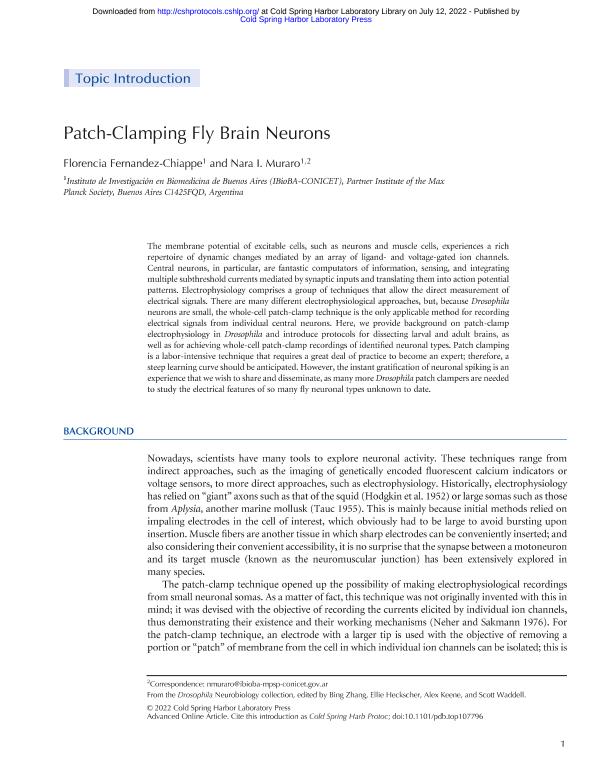Mostrar el registro sencillo del ítem
dc.contributor.author
Fernandez Chiappe, Florencia
dc.contributor.author
Muraro, Nara Ines

dc.date.available
2023-10-20T16:04:13Z
dc.date.issued
2022-08
dc.identifier.citation
Fernandez Chiappe, Florencia; Muraro, Nara Ines; Patch-Clamping Fly Brain Neurons; Cold Spring Harbor Laboratory Press; Cold Spring Harbor Protocols; 2022; 8; 8-2022; 327-332
dc.identifier.issn
1940-3402
dc.identifier.uri
http://hdl.handle.net/11336/215585
dc.description.abstract
The membrane potential of excitable cells, such as neurons and muscle cells, experiences a rich repertoire of dynamic changes mediated by an array of ligand- and voltage-gated ion channels. Central neurons, in particular, are fantastic computators of information, sensing, and integrating multiple subthreshold currents mediated by synaptic inputs and translating them into action potential patterns. Electrophysiology comprises a group of techniques that allow the direct measurement of electrical signals. There are many different electrophysiological approaches, but, because Drosophila neurons are small, the whole-cell patch-clamp technique is the only applicable method for recording electrical signals from individual central neurons. Here, we provide background on patch-clamp electrophysiology in Drosophila and introduce protocols for dissecting larval and adult brains, as well as for achieving whole-cell patch-clamp recordings of identified neuronal types. Patch clamping is a labor-intensive technique that requires a great deal of practice to become an expert; therefore, a steep learning curve should be anticipated. However, the instant gratification of neuronal spiking is an experience that we wish to share and disseminate, as many more Drosophila patch clampers are needed to study the electrical features of so many fly neuronal types unknown to date.
dc.format
application/pdf
dc.language.iso
eng
dc.publisher
Cold Spring Harbor Laboratory Press
dc.rights
info:eu-repo/semantics/openAccess
dc.rights.uri
https://creativecommons.org/licenses/by-nc-sa/2.5/ar/
dc.subject
DROSOPHILA MELANOGASTER
dc.subject
ELECTROPHYSIOLOGY
dc.subject
PATCH-CLAMP
dc.subject
DISSECTION
dc.subject.classification
Biología

dc.subject.classification
Ciencias Biológicas

dc.subject.classification
CIENCIAS NATURALES Y EXACTAS

dc.title
Patch-Clamping Fly Brain Neurons
dc.type
info:eu-repo/semantics/article
dc.type
info:ar-repo/semantics/artículo
dc.type
info:eu-repo/semantics/publishedVersion
dc.date.updated
2023-07-10T11:39:09Z
dc.identifier.eissn
1559-6095
dc.journal.volume
2022
dc.journal.number
8
dc.journal.pagination
327-332
dc.journal.pais
Estados Unidos

dc.description.fil
Fil: Fernandez Chiappe, Florencia. Consejo Nacional de Investigaciones Científicas y Técnicas. Oficina de Coordinación Administrativa Parque Centenario. Instituto de Investigación en Biomedicina de Buenos Aires - Instituto Partner de la Sociedad Max Planck; Argentina
dc.description.fil
Fil: Muraro, Nara Ines. Consejo Nacional de Investigaciones Científicas y Técnicas. Oficina de Coordinación Administrativa Parque Centenario. Instituto de Investigación en Biomedicina de Buenos Aires - Instituto Partner de la Sociedad Max Planck; Argentina
dc.journal.title
Cold Spring Harbor Protocols
dc.relation.alternativeid
info:eu-repo/semantics/altIdentifier/url/http://cshprotocols.cshlp.org/content/2022/8/pdb.top107796.long
dc.relation.alternativeid
info:eu-repo/semantics/altIdentifier/doi/http://dx.doi.org/10.1101/pdb.top107796
Archivos asociados
